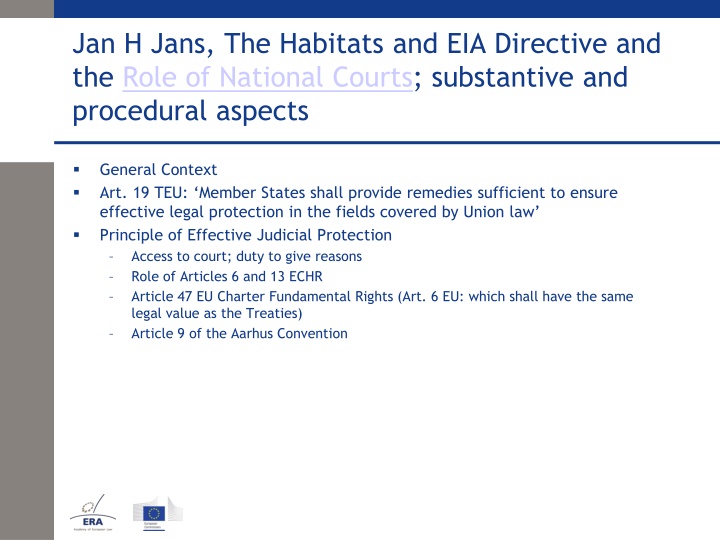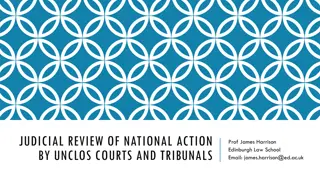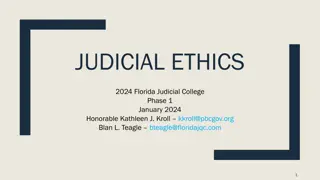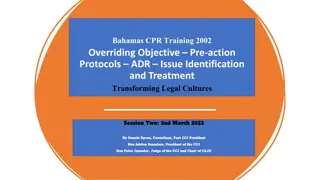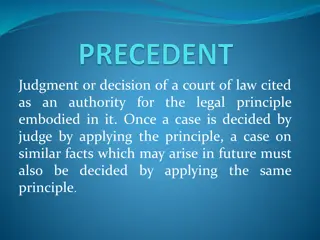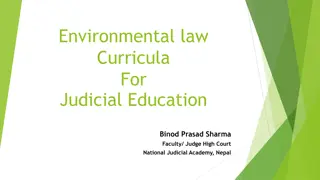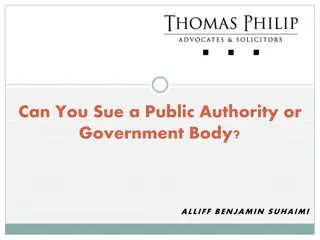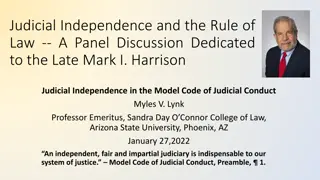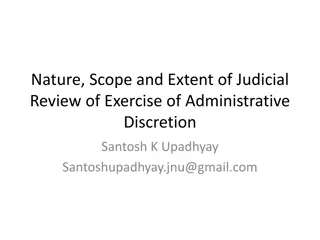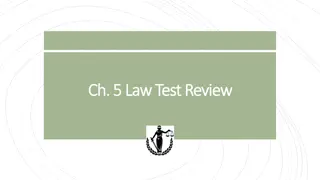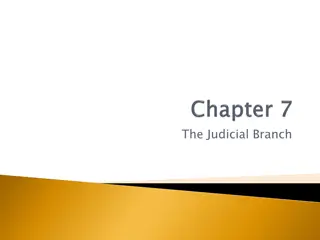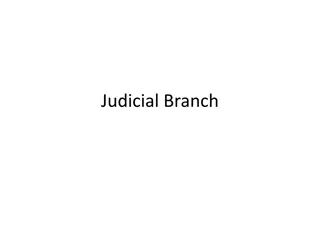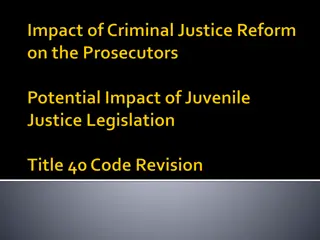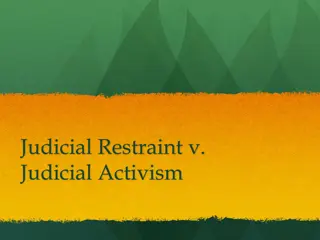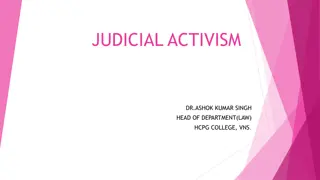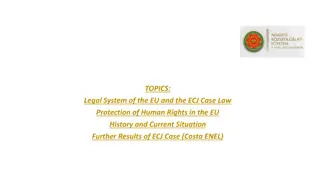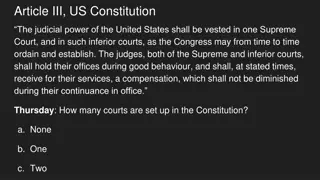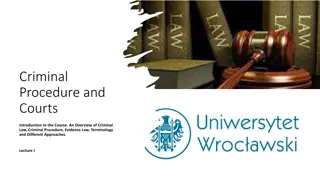Role of National Courts in EU Law: Judicial Protection and Consistent Interpretation
Member States must provide effective legal remedies in fields covered by EU law. National courts play a crucial role in ensuring access to justice and upholding fundamental rights. Consistent interpretation of directives is essential to achieve harmonization across jurisdictions, requiring courts to apply EU law in a manner that aligns with the directive's objectives. Challenges may arise when implementing directives into national law, urging courts to navigate complex legal issues to uphold the principles of EU law.
Download Presentation

Please find below an Image/Link to download the presentation.
The content on the website is provided AS IS for your information and personal use only. It may not be sold, licensed, or shared on other websites without obtaining consent from the author.If you encounter any issues during the download, it is possible that the publisher has removed the file from their server.
You are allowed to download the files provided on this website for personal or commercial use, subject to the condition that they are used lawfully. All files are the property of their respective owners.
The content on the website is provided AS IS for your information and personal use only. It may not be sold, licensed, or shared on other websites without obtaining consent from the author.
E N D
Presentation Transcript
Jan H Jans, The Habitats and EIA Directive and the Role of National Courts; substantive and procedural aspects General Context Art. 19 TEU: Member States shall provide remedies sufficient to ensure effective legal protection in the fields covered by Union law Principle of Effective Judicial Protection Access to court; duty to give reasons Role of Articles 6 and 13 ECHR Article 47 EU Charter Fundamental Rights (Art. 6 EU: which shall have the same legal value as the Treaties) Article 9 of the Aarhus Convention
When things go wrong.. Consistent Interpretation Direct effect State liability
Consistent Interpretation Ground rules: Marleasing as far as possible Pfeiffer: all national law No duty before expiration implementation deadline However, CI-light according to Adeneler: courts must refrain as far as possible from interpreting domestic law in a manner which might seriously compromise attainment of the objective pursued by that directive Priority of consistent interpretation; First CI, then DE Problems: CI always concerns the application of national law; is there a connecting point ? Court is not a legislator or executive authority: To do whatever lies within their jurisdiction No contra legem; Pupino; A cow is not a horse Case Law CJEU: Slovak Brown Bear case
Example: Case Dutch Council of State Agricultural project in the Netherlands, with significant effects on German Natura-2000 site Habitats Directive in NL implemented via the Nature Conservation Act Problem: definition of Natura-2000 site is explicitly restricted to Dutch sites only (legislative amendment is pending) What if the restriction is more implicit? Route 1: Consistent interpretation of NCA (contra legem?) Route 2: Consistent interpretation of Dutch Environmental Management Act (but what if it concerns an activity for which no environmental permit is required?)
Direct Effect Ground rules: To rely on European law before a national court unconditional and sufficiently precise Vertical direct effect: a citizen relying on Community law vis a vis public authorities (central, regional, local etc.) Duty for courts and public authorities alike; Costanzo obligation Consequences: national law to set aside; cannot be applied against individuals Problems: Discretion; Waddenzee case (Habitats Directive); Kraaijeveld case (EIA Directive) Direct effect and individual rights ? Inverse direct effect: state relies on directive against an individual; Wells case, Flughafen Salzburg case
Case study; Baker v Bath and North East Somerset Council The Case: Claimant seeks to quash three planning permissions granted by the local authority for the expansion of two waste management sites run by Hinton Organics. Original permit dates from 1999.
The EIA Directive Annex I identifies projects which must be made subject to an environmental impact assessment and annex 2 contains those which may be subject to such an assessment. For annex II projects Member States shall determine through: (a) a case by case examination, or (b) thresholds or criteria set by the Member State whether the project shall be made subject to an assessment. Project was below the treshhold defined in national law implementing the Directive Why is this case a good example of the doctrine developed in Wells? The original planning permission of 1999 was not submitted to EIA either. What to do about that?
To disapply national regulations not in conformity with the Directive This court clearly is able to disapply a particular provision of the regulations if that provision is inconsistent with a Directive which it purports to implement and that is what I am asked to do in the circumstances of this case .. I have come to the conclusion that the regulations do not .. properly implement the Directive. This is because they seek to limit consideration for the purposes of screening to consideration of the change or extension on its own. That is, in my view, contrary to the purpose of and the language of the Directive and the approach that should be adopted as set out by the court. Accordingly, the order that I make is that all three permissions must be quashed.
State Liability Ground rule: that individuals who have been harmed have a right to reparation if three conditions are met: the rule of European Union law infringed must be intended to confer rights on them; the breach of that rule must be sufficiently serious; and there must be a direct causal link between that breach and the loss or damage sustained by the individuals Problems: Individual rights? Environmental damage? Causality Case law: Jutta Leth Facts Reasoning of the CJEU Comments
Procedural consequences: standing, costs, etc Ground rules: Procedural autonomy; applicability of national procedural law (Rewe/Comet case law) In the absence of specific harmonising provisions: procedural autonomy (time limits, costs, locus standi etc) Equivalence (or non-discrimination); the rules that govern a dispute with a EU dimension may not be less favourable than those governing similar domestic actions Effectiveness (effet utile; rule of reason); the rules must not render virtually impossible or excessively difficult the exercise of rights conferred by the EU legal order Growing importance of Article 47 EU Charter Fundamental Rights (right to an effective remedy)
From Procedural Autonomy to Aarhus Compatability (1) EIA Directive has imported Art. 9(2, 4) of the Aarhus Convention by copy/paste Djurgarden case Members of the public concerned , must be able to have access to a review procedure to challenge the decision on a request for development consent Article 11 of the EIA Directive precludes a provision of national law which reserves the right to bring an appeal against a decision on projects which fall within the scope of that directive, as amended, solely to environmental protection associations which have at least 2 000 members
From Procedural Autonomy to Aarhus Compatability (2) Habitats Directive imports Art. 9(3-4) of the Aarhus Convention via the case law of the CJEU Slovak Brown Bear case Article 9(3) of the Aarhus Convention does not have direct effect in EU law it is for the national court, in order to ensure effective judicial protection in the fields covered by EU environmental law, to interpret its national law in a way which, to the fullest extent possible, is consistent with the objectives laid down in Article 9(3) of the Aarhus Convention in order to enable an environmental protection organisation to challenge before a court a decision taken following administrative proceedings liable to be contrary to European Union environmental law.
Article 9 (3-4) Aarhus Convention (3) In addition and without prejudice to the review procedures referred to in paragraphs 1 and 2 above, each Party shall ensure that, where they meet the criteria, if any, laid down in its national law, members of the public have access to administrative or judicial procedures to challenge acts and omissions by private persons and public authorities which contravene provisions of its national law relating to the environment. 4. In addition and without prejudice to paragraph 1 above, the procedures referred to in paragraphs 1, 2 and 3 above shall provide adequate and effective remedies, including injunctive relief as appropriate, and be fair, equitable, timely and not prohibitively expensive. Decisions under this article shall be given or recorded in writing. Decisions of courts, and whenever possible of other bodies, shall be publicly accessible
Case study: Trianel case EIA in Germany Implementation of Directive 2003/35 by the Umweltrechtbehelfsgesetz environmental organisations can only bring actions on grounds of the violation of legislation which confers individual rights ( dem Umweltschutz dienen, Rechte Einzelner begr nden und f r die Entscheidung von Bedeutung sind ) CJEU: A non-governmental organisation, which promotes environmental protection, can derive the right to rely before the courts, in an action contesting a decision authorising projects likely to have significant effects on the environment when, on the ground that the rules relied on protect only the interests of the general public and not the interests of individuals, national procedural law does not permit this
Aftermath of the Trianel case Germany changed its law and broadened the grounds for appeal of NGOs However, they inserted a new provision: Soweit der Verwaltungsbeh rde bei der Anwendung umweltrechtlicher Vorschriften eine Beurteilungserm chtigung einger umt ist, ist eine beh rdliche Entscheidung im gerichtlichen Verfahren nur daraufhin zu berpr fen, ob 1. der Sachverhalt vollst ndig und zutreffend erfasst wurde, 2. die Verfahrensregeln und die rechtlichen Bewertungsgrunds tze eingehalten wurden, 3. das anzuwendende Recht verkannt wurde, 4. sachfremde Erw gungen vorliegen. What do you think of this?
Varia (1) Availability at national law for interim relief measures Case C-416/10 Kri an; members of the public concerned must be able, in the context of the action provided for by that provision, to ask the court or competent independent and impartial body established by law to order interim measures such as temporarily to suspend the application of a permit, within the meaning of Article 4 of that directive, pending the final decision pending case Case C-530/11, Commission v. UK Preclusion/Pr klusion?
Varia (2) Costs of litigation ( not prohibitively expensive ) Edwards case, C-260/11 people should not be prevented from pursuing a claim by reason of the financial burden which might arise as a result the court should not exclusively look at the estimated financial resources of an average claimant, as this may have little connection with the situation of the person concerned. Nor must one look solely at the claimant s financial situation the court may also take into account the situation of the parties concerned, whether the claimant has a reasonable prospect of success, the importance of what is at stake for the claimant and for the protection of the environment, the complexity of the relevant law and procedure, the potentially frivolous nature of the claim at its various stages, and the existence of a national legal aid scheme or a costs protection regime.
